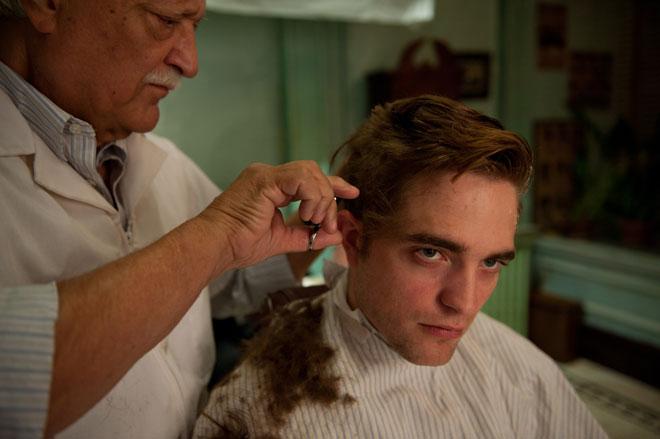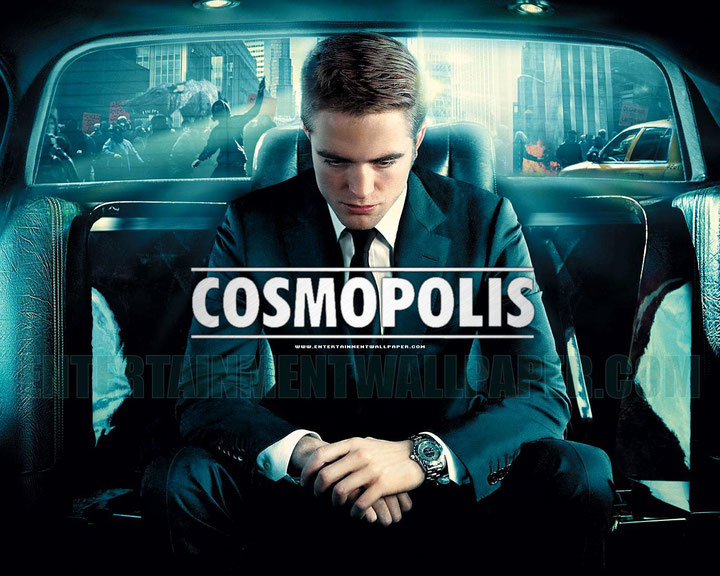Issue 4/2012 - Net section
A Rat Becomes the Unit of Currency
»Cosmopolis« and the Logic of Late Capitalism
The 2008 financial meltdown sent shockwaves throughout the world which are still felt today. One of the most interesting cinematic attempts to deal with this disaster came out recently with David Cronenberg´s film »Cosmopolis« (2012) which is based on the book by Don Delillo under the same title. Delillo’s book, published in 2003, is a sort of literary expansion on the philosophy of Jean Baudrillard and his clairvoyant ideas about hyper–capitalism and simulation. In this article I explore these three »sites« – the book, the film and the philosophy – which combine to give a unique vision of late capitalism and its current crises.
»Cosmopolis« in Greek stands for »universe city« or »order city«, and hence the story takes place in New York, the heart of the financial world as well as the source of its meltdown. The narrative unfolds a day in the life of Eric Packer (Robert Pattinson), a young financial mogul who made multimillions on the stock exchange. Eric represents what is dubbed today as the 1%; the highest socio–economic layer which controls most of the world’s financial institutions and corporations. The story begins with Eric’s wish to take a haircut on the other side of the city. From here on everything takes place almost entirely inside his luxurious limousine on its way to the barbershop. Throughout the film Eric almost never leaves his spacious limo which functions as a mobile office that contains large leather sofas, touch screens, data displays, a mini–bar and even a toilet. Completely shielded from the outside, the limo symbolizes the isolation of the 1%. On an aesthetic level it functions as a mobile theater, where other characters enter to meet with Eric, exchanging dialogues which seem to be taken straight out of Baudrillard’s social theory texts.1 The seemingly simple journey to the barbershop is hindered by various obstacles – the President is in town with his entourage, while the city is in general uproar, as major demonstrations take place. These are the 99%, who fill the streets chanting the slogan ›A spectre is haunting the world.‹ Although originally a line from Marx and Engels’ »Manifesto of the Communist Party« which refers to communism (›A spectre is haunting Europe — the spectre of communism‹), here the spectre is late capitalism, represented by Eric, who passes through the demonstrators in the streets without their knowledge, hidden behind the darkened windows of his limo like an invisible ghost.
According to Baudrillard, late capitalism no longer bases capital on the real. Eric’s job at Wall Street means, as his wife describes it, to ›know things‹, to ›acquire information and turn it into something stupendous and awful.‹ Yet information itself becomes in this state of affairs a pure spectacle, unreadable and meaningless, just as money lost its material counterpart (in the United States the dollar is not backed by gold or any other real substance since 1933). Both the Times Square protesters and Eric are therefore fascinated by a phrase from a Zbigniew Herbert’s poem: »A rat becomes the unit of currency.«2 Whether the currency is called ›dollar‹, ›yen‹ or ›rat‹ makes no difference in the simulation state of capital, which according to Baudrillard generates models of the real without origin or reality; a hyperreal which »is inaugurated by a liquidation of all referentials.«3 According to this logic, capital is no longer exchanged for anything but itself. As Eric’s chief of theory explains, »Money has taken a turn. All wealth has become wealth for its own sake. There’s no other kind of enormous wealth. Money has lost its narrative quality the way painting did once upon a time. Money is talking to itself.«4
Eric stands for this self–enclosed state of late capitalism, which like his limo, is supposed to be a sterile space, completely impenetrable to the gritty, dirty reality outside (where the 99% live their lives). Yet during the day in which we follow Eric this premise changes: Eric is losing all his money betting against the yen currency which fails to stop rising, and while we observe him descend into bankruptcy his clean limo loses its sterile look as it is being attacked by angry protesters who spray paint and hammer it down. Gradually Eric himself becomes filthy and messy looking. In the beginning Eric seems posed and in complete control not only over the financial markets, his limo and his limo guests, but also over his own body. He believes everything can be put into equations and charts and therefore takes daily medical check–ups to chart his own body; yet he is haunted by the yen currency which doesn’t chart, just like his own prostate, which his doctor proclaims to be asymmetrical. Eric’s battle against chaos is symbolized by his insistence on reaching his destination, despite the mayhem engulfing the city. Yet when he finally reaches the barbershop the chaos has already penetrated his soul and he leaves the barbershop in the middle of his haircut, with half done hair and a rattled appearance. The final scene where he will meet his nemesis takes place outside the protecting shield of the limo, in a dirty, crumbling building which reflects Eric’s state of mind.
As Eric’s chief of theory sees it, chaos and cosmos are not opposites in the capitalist system, which is actually a reflection of its anarchist foes. The anarchists demonstrating outside the limo, she says, always believed that the urge to destroy is a creative urge, and this is also »the hallmark of capitalist thought. Enforced destruction. Old industries have to be harshly eliminated. New markets have to be re–exploited. Destroy the past, make the future.« Eric therefore leads himself towards his own destruction; just as Marx predicted, capitalism will produce its own downfall5. Eric betrays his wife and she leaves him, he loses all his wealth and finally, willingly enters the house of a man who wants to kill him. What is the point, then, in political resistance to capitalism? According to »Cosmopolis«, political activism is no more (and no less) than art. All the political acts in the film/book appear as art performances, including the graffiti »attack« on the limo which results in something which looks like an abstract modern painting. Andre Petrescu, the »assassin« who manages to infiltrate Eric’s security is a »pastry assassin« who hits Eric’s face with a cream pie. An »assassination« which replaces symbolic value for the real, an art performance (Petrescu calls himself an ›action painter of cream pie‹) which suits perfectly the simulation politics of late capitalism (and which nonetheless is responded to by real physical violence). Just like money has lost its relation to the real, so does politics.
Why does Eric enter the house of Benno Levin (Paul Giamatti), who wishes to kill him? It is the contradiction of capitalism itself which leads to its own destruction. As Levin tells Eric, »your whole fucking waking life is a self–contradiction. That’s why you’re engineering your own downfall.« Yet this notion takes the power of the people (represented here by Levin) out of their own hands. The fall of capitalism is capitalism’s own doing, and all that’s left for the ›revolutionaries‹ is to give a performance of resistance. Eric therefore calls Levin’s wish to destroy him a »cheap imitation«, a »stale fantasy. People do it because other people do it. It’s another syndrome, a thing you caught from others. It has no history.« – »It’s all history«, cries Levin, »the whole thing is history. You are foully and berserkly rich.« Eric replies that Levin is not driven by oppressive social force. »You’re not against the rich. Nobody’s against the rich. Everybody’s ten seconds from being rich. Or so everybody thought. No. Your crime is in your head.« Levin in reply insists that »whether I imagine a thing or not, it’s real to me. The things I imagine become facts. They have the time and space of facts.« Yet this is precisely the mark of simulation, which is not just to feign to have what one doesn’t have. As Baudrillard writes »Whoever fakes an illness can simply stay in bed and make everyone believe he is ill. Whoever simulates an illness produces in himself some of the symptoms. […] Simulation threatens the difference between the ›true‹ and the ›false‹, the ›real‹ and the ›imaginary‹.«6 In this state of suspension, undecided between these terms, the film ends. While in the book Levin indeed eventually kills Eric, Cronenberg decided to leave it open and not to show a final resolution, which in fact is more fitting to Baudrillard’s description of the simulation as an »operation of deterring every real process […] a system of death, or rather of anticipated resurrection, that no longer even gives the event of death a chance.«7 The only gunshot fired at the last scene of the film is from Eric’s own gun, shooting at his own palm. The stigmata–like hole, together with Levin’s words »I wanted you to save me« draws a picture of Eric as the capitalist anti– Christ, a self sacrificing false messiah that once was supposed to deliver utopia and the ›end of history‹ and now destroys himself only to threaten everybody else with calamity.
1 Not accidentally, the only character who takes the main seat in the limo, while Eric takes the guest seat, is Eric’s »chief of theory«.
2 Zbigniew Herbert, Report from the Besieged City.
3 Baudrillard, Simulacra and Simulation , p. 2
4 In many ways this film brings to mind Cronenberg’s earlier film »eXistenZ« (1999), which portrays a world of simulation without an outside and with no referent to the real.
5 »What the bourgeoisie therefore produces, above all, are its own grave–diggers. Its fall and the victory of the proletariat are equally inevitable.« (Manifesto of the Communist Party, p.12)
6 Ibid, p. 3
7 Ibid, p. 2

